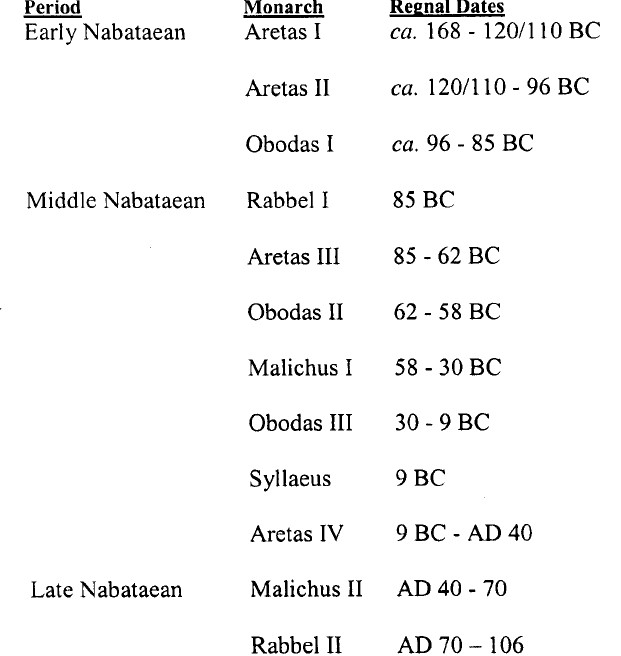Archeological References
Chronology
| Age | Dates | Comments |
|---|---|---|
| Early Bronze IA-B | 3300-3000 BCE | |
| Early Bronze II | 3000-2700 BCE | |
| Early Bronze III | 2700-2200 BCE | |
| Middle Bronze I | 2200-2000 BCE | EB IV - Intermediate Bronze |
| Middle Bronze IIA | 2000-1750 BCE | |
| Middle Bronze IIB | 1750-1550 BCE | |
| Late Bronze I | 1550-1400 BCE | |
| Late Bronze IIA | 1400-1300 BCE | |
| Late Bronze IIB | 1300-1200 BCE | |
| Iron IA | 1200-1150 BCE | |
| Iron IB | 1150-1100 BCE | |
| Iron IIA | 1000-900 BCE | |
| Iron IIB | 900-700 BCE | |
| Iron IIC | 700-586 BCE | |
| Babylonian & Persian | 586-332 BCE | |
| Early Hellenistic | 332-167 BCE | |
| Late Hellenistic | 167-37 BCE | |
| Early Roman | 37 BCE - 132 CE | |
| Herodian | 37 BCE - 70 CE | |
| Late Roman | 132-324 CE | |
| Byzantine | 324-638 CE | |
| Early Arab | 638-1099 CE | Umayyad & Abbasid |
| Crusader & Ayyubid | 1099-1291 CE | |
| Late Arab | 1291-1516 CE | Fatimid & Mameluke |
| Ottoman | 1516-1917 CE | |
| Phase | Dates | Variants |
|---|---|---|
| Early Bronze IA-B | 3400-3100 BCE | |
| Early Bronze II | 3100-2650 BCE | |
| Early Bronze III | 2650-2300 BCE | |
| Early Bronze IVA-C | 2300-2000 BCE | Intermediate Early-Middle Bronze, Middle Bronze I |
| Middle Bronze I | 2000-1800 BCE | Middle Bronze IIA |
| Middle Bronze II | 1800-1650 BCE | Middle Bronze IIB |
| Middle Bronze III | 1650-1500 BCE | Middle Bronze IIC |
| Late Bronze IA | 1500-1450 BCE | |
| Late Bronze IIB | 1450-1400 BCE | |
| Late Bronze IIA | 1400-1300 BCE | |
| Late Bronze IIB | 1300-1200 BCE | |
| Iron IA | 1200-1125 BCE | |
| Iron IB | 1125-1000 BCE | |
| Iron IC | 1000-925 BCE | Iron IIA |
| Iron IIA | 925-722 BCE | Iron IIB |
| Iron IIB | 722-586 BCE | Iron IIC |
| Iron III | 586-520 BCE | Neo-Babylonian |
| Early Persian | 520-450 BCE | |
| Late Persian | 450-332 BCE | |
| Early Hellenistic | 332-200 BCE | |
| Late Hellenistic | 200-63 BCE | |
| Early Roman | 63 BCE - 135 CE | |
| Middle Roman | 135-250 CE | |
| Late Roman | 250-363 CE | |
| Early Byzantine | 363-460 CE | |
| Late Byzantine | 460-638 CE | |
| Early Arab | 638-1099 CE | |
| Crusader & Ayyubid | 1099-1291 CE | |
| Late Arab | 1291-1516 CE | |
| Ottoman | 1516-1917 CE | |
 Table 1
Table 1A chronological scheme for the Levant (after Finkelstein 2010 and 2011; Regev et al. 2012; Sharon 2013).
Palmisano et al. (2019)
- from Fall et al. (2023)
 Table 1
Table 1Traditional and revised Early and Middle Bronze Age chronologies for the Southern Levant. (Traditional chronology based on Dever 1992; Levy 1995:fig. 3; revised chronology based on Regev et al. 2012; Fall et al. 2021; Höflmayer and Manning 2022.)
Fall et al. (2023)
| Age | Dates | Comments |
|---|---|---|
| Early Islamic I | 600-800 CE | |
| Early Islamic II | 800-1000 CE | |
| Middle Islamic I | 1000-1200 CE | |
| Middle Islamic II | 1200-1400 CE | |
Encyclopedias
Stern, E., et al. (1993).
The New Encyclopedia of Archaeological Excavations in the Holy Land, Israel Exploration Society & Carta. Volume 1 - Abila to Elusa..
1
Stern, et al. (1993). The New Encyclopedia of Archaeological Excavations in the Holy Land,
Israel Exploration Society & Carta. Volume 2 - Emmaus to Jerusalem - can be borrowed with a free acount at archive.org..
2
Stern, et al. (1993). The New Encyclopedia of Archaeological Excavations in the Holy Land,
Israel Exploration Society & Carta. Volume 3 - Jokneam to Pella - can be borrowed with a free acount at archive.org..
3
Stern, et al. (1993). The New Encyclopedia of Archaeological Excavations in the Holy Land, Israel Exploration Society & Carta. Volume 4 - Petra to Ziqim..
4
Stern, et al. (2008). The New Encyclopedia of Archaeological Excavations in the Holy Land, Israel Exploration Society & Carta. Volume 5 Supplement..
5
The New Encyclopedia of Archaeological Excavations in the Holy Land at BAS
(Biblical Archaeology Society) - requires a membership to access
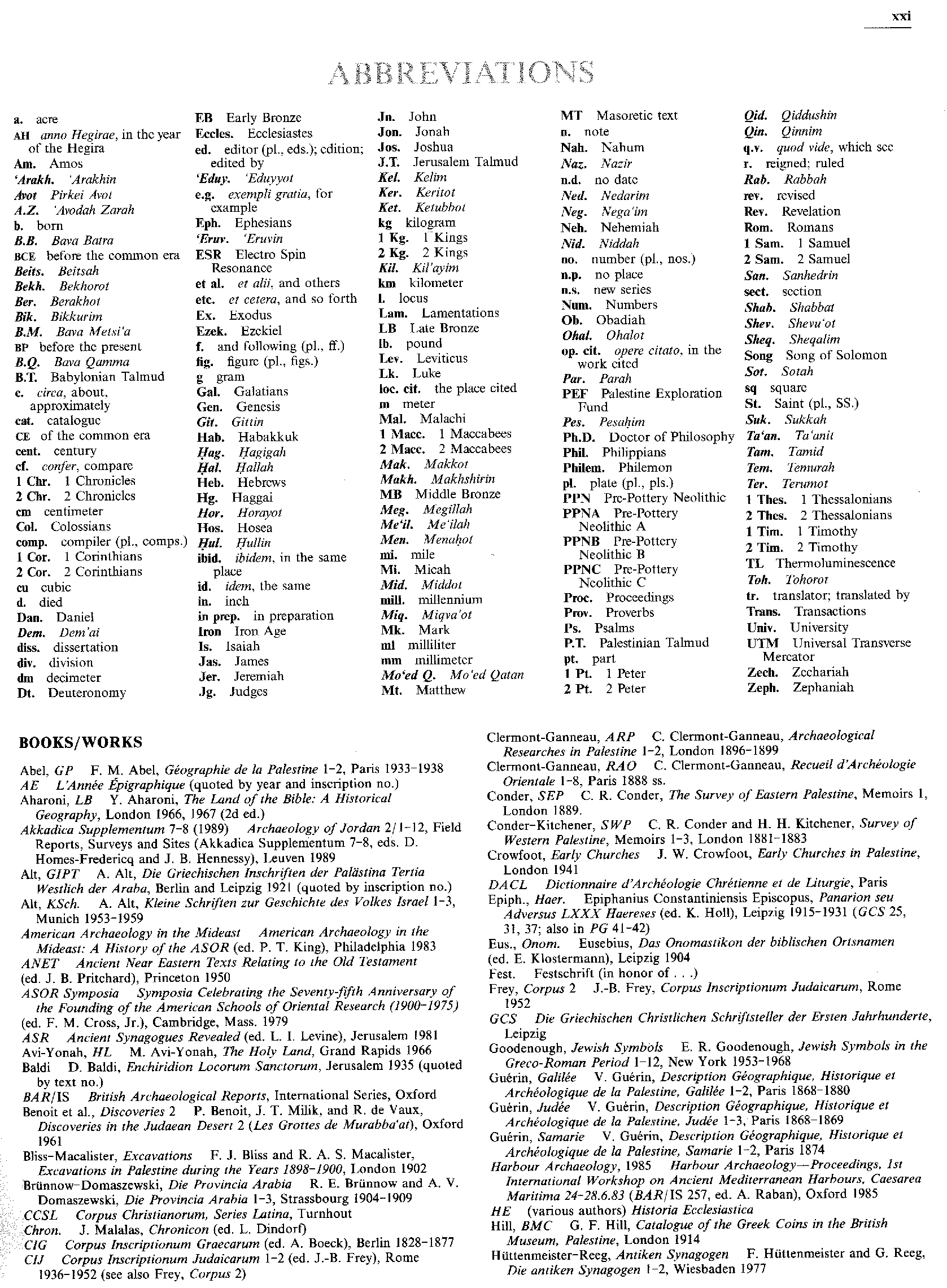
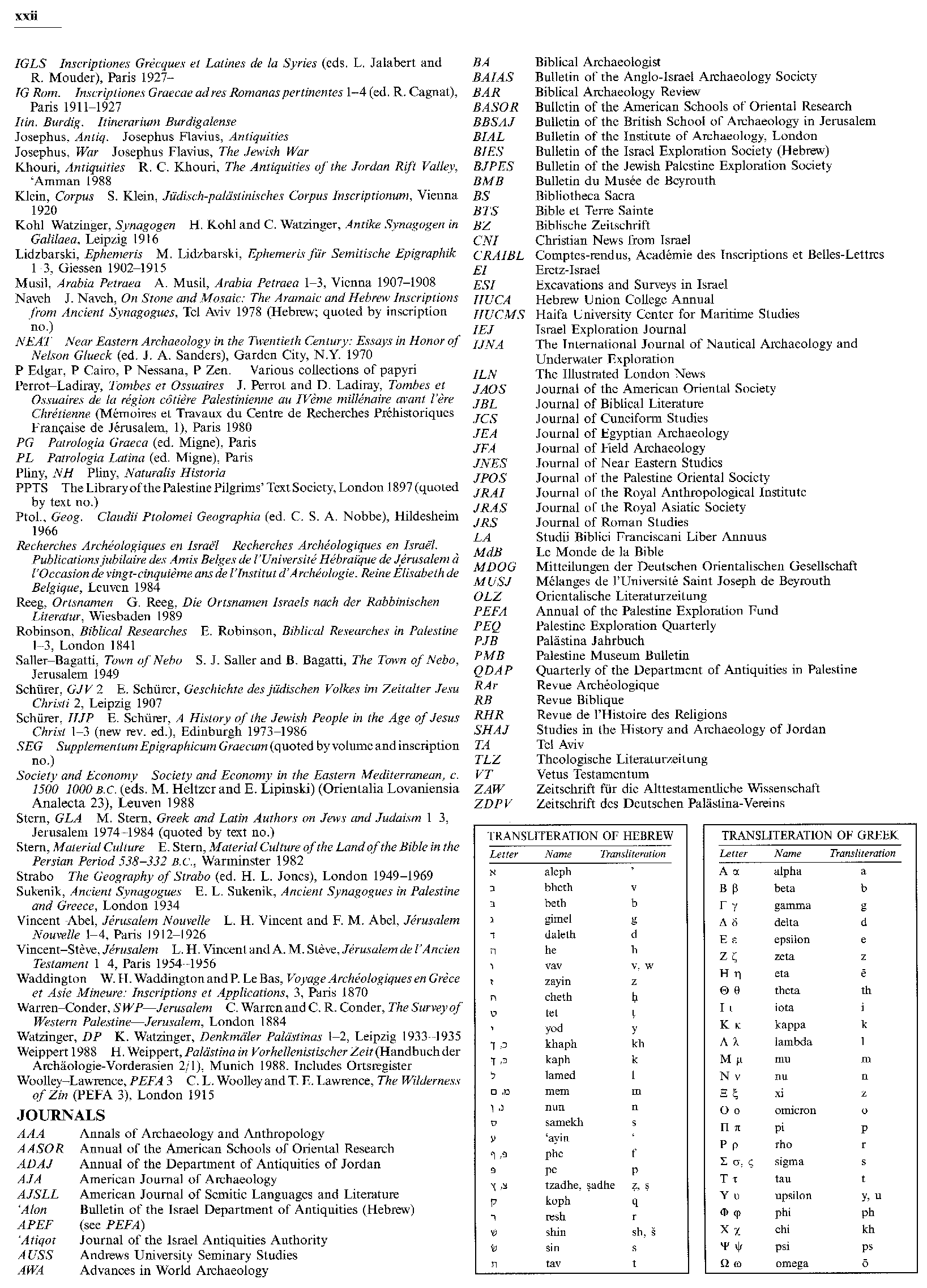




Meyers, É. M. (1997). The Oxford encyclopedia of archaeology in the Near East. New York, N.Y.; Oxford, Oxford University Press..
O


Avi-Yonah, M. (1975). The Encyclopedia of Archaeological Excavations in the Holy Land, Israel Exploration Society and Massada Press. English Version.
Volume I - Abu Ghosh to Dothan -
can be borrowed with a free account at archive.org..
I
Volume II - Eboda to Jerusalem..
II
Volume III - Jisr Banat Ya'aqub to Nassana -
can be borrowed with a free account at archive.org..
III
Volume IV - Or Ha-Ner to Tel Zeror -
can be borrowed with a free account at archive.org..
IV
Negev, A. and S. Gibson (2004).
Archaeological encyclopedia of the Holy Land, Bloomsbury Publishing - can be borrowed with a free account at archive.org
Negev, A. and N. A. Silberman (1990).
The Archaeological Encyclopedia of the Holy Land 3rd Edition , Prentice Hall Press -
can be borrowed with a free account at archive.org
Negev, A.(1980).
The Archaeological Encyclopedia of the Holy Land 2nd Edition, Prentice Hall Press..
N
Negev, A. (1972) Archaeological encyclopedia of the Holy Land 1st Edition. -
can be borrowed with a free account at archive.org.
Negev, A. (1986). Nabatean archaeology today. New York, New York Univ. Press. -
can be borrowed with a free account at archive.org.
The Princeton Encyclopedia of Classical Sites - online open access at perseus.tufts.edu
Steiner, M. and A. Killebrew (2014). The Oxford Handbook of the Archaeology of the Levant c.8000–332 BCE..
O
Master, D. (2013) The Oxford encyclopedia of the Bible and archaeology v.2 -
can be borrowed with a free account from archive.org
Potts, D. T. (2012). A Companion to the Archaeology of the Ancient Near East, Wiley..
C
Magness, J. (2012). The Archaeology of the Holy Land: From the Destruction of
Solomon's Temple to the Muslim Conquest, Cambridge University Press..
J
Adams, Russell (ed.) Jordan An Archeological Reader..
JAR
Levy, T. E. (1998). Archaeology of Society in the Holy Land, Bloomsbury Academic -
open access at academia.edu..L
Greenberg, R. (2019). The Archaeology of the Bronze Age Levant: From Urban Origins to the Demise of City-States, 3700–1000 BCE. Cambridge, Cambridge University Press..
ABAL
References
- from Archaeologs
Pottery
Amiran, R. (1970). Ancient Pottery of the Holy Land:
From Its Beginnings in the Neolithic Period to the End of
the Iron Age. Israel: Rutgers University Press. - probably outdated - can be borrowed with a free account from archive.org
Aviram, J., et al. (2015). The ancient pottery of Israel and its neighbors : from the Iron Age through the Hellenistic period. Jerusalem, Israel Exploration Society Jerusalem. 2 Volumes
Brainerd, G.W., 1951. The place of chronological ordering in archaeological analysis.
Am. Antiq. 16, 301–313. - JSTOR
Levantine Pottery - Wikipedia
Sauer, J.A. (1973) Heshbon pottery 1971. A preliminary report on the
pottery from the 1971 excavations at Tell Ḥesbân (= Andrews University monographs 7),
Andrews University Press, Berrien Springs - used by Parker in Limes Arabicus excavations in Jordan - can be borrowed with a free account at archive.org
Schmid, S. (1995) Nabataean Fine Ware from Petra SHAJ V
- from Schmid (1995)
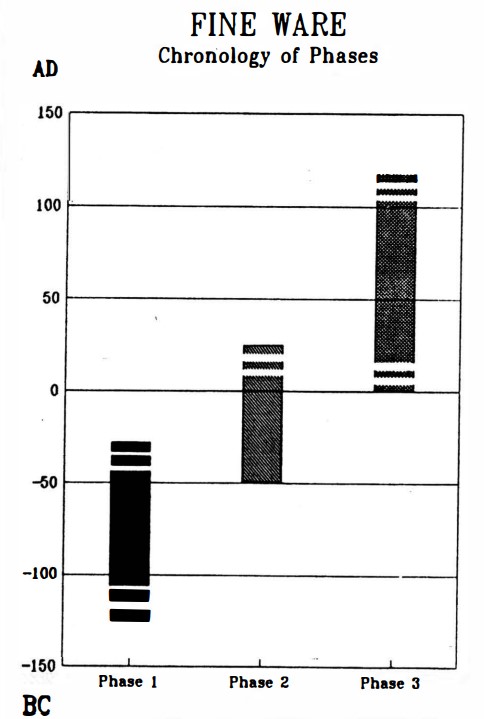
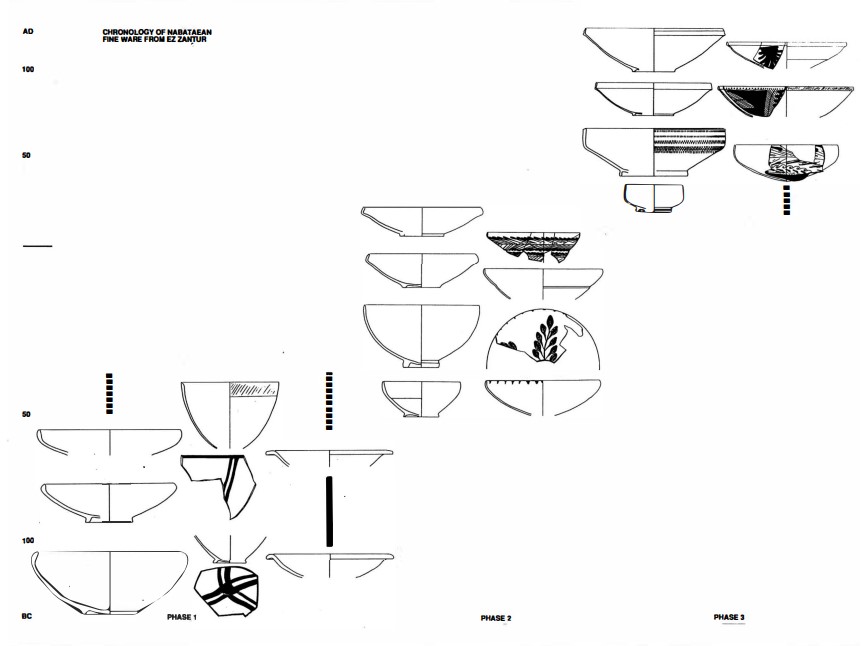
Left
Chronology of Nabatean finewares
Right
Typology and chronology of the Nabataean fine ware
Both from Schmid (1995)
- from Dolinka (2006) citing Schmid (2000)
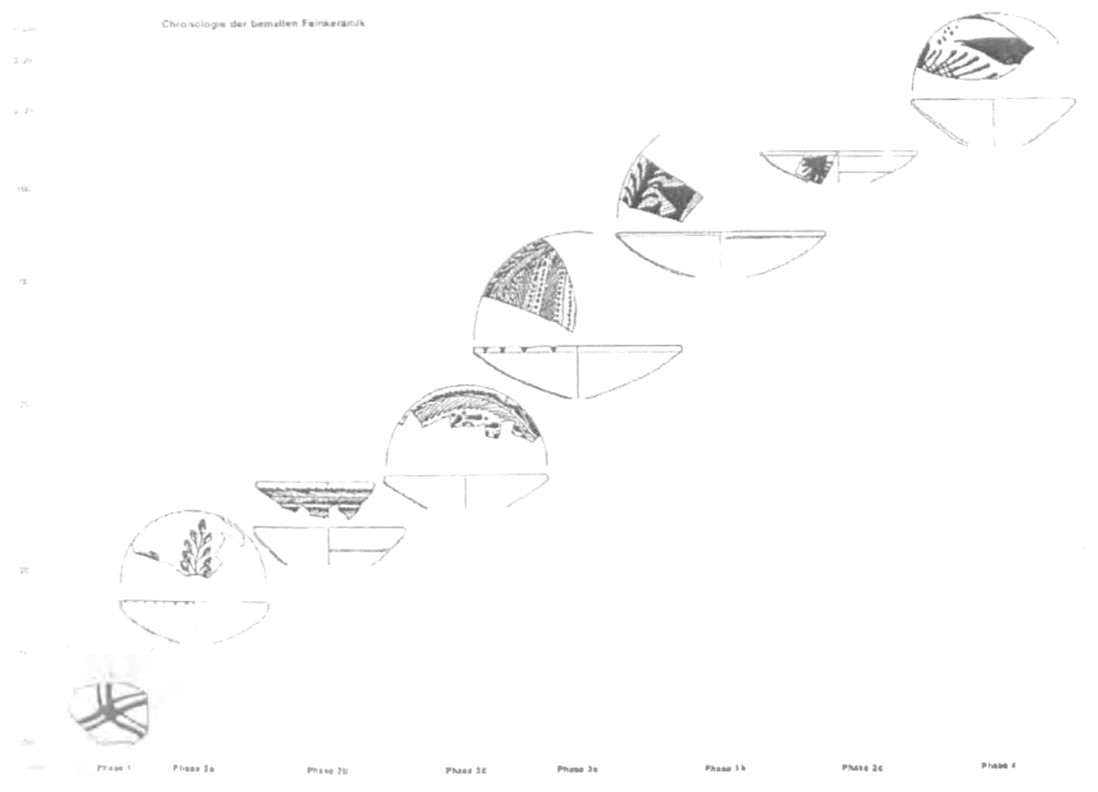 Figure 1.3
Figure 1.3Typo-chronology for the NPFW bowls developed by Schmid (2000: abb. 98)
Dolinka (2006)
Journals and Publications
Hadashot Arkheologiyot - Excavations and Surveys in Israel
Hadashot Arkheologiyot - Extended Reports
Hadashot Arkheologiyot - Search page
Hadashot Arkheologiyot at JSTOR - good for older issues
Atiqot - past issues
Atiqot on JSTOR - goes back to the 1990's
Qadmoniot: A Journal for the Antiquities of
Eretz-Israel and Bible Lands on JSTOR
QEDEM on JSTOR
Israel Exploration Journal (IEJ) at JSTOR
Bulletin of the Israel Exploration Society at JSTOR
IAA List of Publications
IAA archives - 1919-1948
IAA Reports at JSTOR
Hadashot Arkheologiyot - List of References
Palestinian Exploration Quarterly Back Issues.
(also available at Taylor and Francis and z library)
Qedem Reports at JSTOR
Quarterly Of The Department Of Antiquities In Palestine Vol.1 - open access at archive.org
Quarterly Of The Department Of Antiquities In Palestine Vol.2 - open access at archive.org
Quarterly Of The Department Of Antiquities In Palestine Vol.3 - open access at archive.org
Quarterly Of The Department Of Antiquities In Palestine Vol.4 - open access at archive.org
Quarterly Of The Department Of Antiquities In Palestine Vol.5 - open access at google play
Quarterly Of The Department Of Antiquities In Palestine Vol.6 - open access at google play
Quarterly Of The Department Of Antiquities In Palestine Vol.7 - open access at google play
Quarterly Of The Department Of Antiquities In Palestine Vol.8 - open access at google play
Quarterly Of The Department Of Antiquities In Palestine Vol. 9-10 - open access at google play
Quarterly Of The Department Of Antiquities In Palestine Vol. 11-12 - open access at google play
Quarterly Of The Department Of Antiquities In Palestine Vol. 12 - open access at google play
Quarterly Of The Department Of Antiquities In Palestine Vol. 12-13 - open access at google play
American Journal of Archaeology (AJA) Archive
Council for British Research in the Levant (CBRL) Publications
List of Open Access Journals in Ancient Studies
Online Journal and Research Databases.
OpenEdition.org - database of Books, Journals, Blogs, and Events
sHub alternative links
Orient Lab - Open Access Near East Archaeological Publications (includes ICAANE)
Vetus Testamentum at JSTOR
Liber Annus
Dumbarton Oaks Papers
Dumbarton Oaks papers sorted by subject
Revue de l’Orient Chretien online; list of Syriac-related articles and links - Roger Pearse
www.persee.fr - Arts (History of art, Architecture)
www.persee.fr - Classical Studies
AWOL - The Ancient World Online
Online Publications of the German Orientalist Society (Zeitschrift der Deutschen Morgenländischen Gesellschaft) from 1847 to 2013
Al-ʿUṣūr al-Wusṭā: The Journal of Middle East Medievalists (open access)
Journal Asiatique at BnF - open access - 1822-1940
Journal Asiatique at Peeters - open access - 1999-present
The journal of the Palestine Oriental Society (JPOS) 1920-1948 open access
The Journal of the Royal Asiatic Society of Great Britain and Ireland at JSTOR - 1824 - 2016
Bulletin d'études orientales (B.E.O.) at JSTOR
Revue Biblique at JSTOR
Cahiers de la Revue Biblique (Books)
Aerial Images
Inscriptions
Papyri
Other References
IAA archives - 1919-1948
The Digital Archaeological Record
Institut Francais du Proche-Orient
www.persee.fr
www.persee.fr - Archaeology
www.persee.fr - Arts (History of art, Architecture)
www.persee.fr - Classical Studies
Open Edition Books - open access - includes books on history and archaeology
EAMENA - Endangered Archaeology in the Middle East and North Africa
Ancient Ports - THE catalogue of Ancient Ports
Ancient Ports - THE catalogue of Ancient Ports - Levant
The Ancient Theatre Archive
biblical-archaeology.org - interactive map and references
Material Sources for Early Islam and Late Antique Near East
Material Sources for Early Islam and Late Antique Near East - Jordan Archaeology
Material Sources for Early Islam and Late Antique Near East - Israel and Palestine Archaeology
Material Sources for Early Islam and Late Antique Near East - Lebanon and Syria Archaeology
open-archaeo - A list of open source archaeological software and resources
Maps and Archaeological Maps
| Link | Notes |
|---|---|
| IAA Survey WebSite | |
| Interactive Maps from IAA | |
| Map of Israel | higher resolution aerial imagery than Google (in Hebrew and English) |
| MEGA Jordan - GIS inventory of archeological sites in Jordan | |
| Mediterranean Archaeological Network (MedArchNet) | |
| Digital Archeological Atlas of the Holy Land | |
| BibleMapper.com |
- Fig. 2.1 Early Bronze I Sites
from Greenberg (2019)

 Fig. 2.1
Fig. 2.1
Map of sites mentioned in this chapter
Greenberg (2019) - Fig. 3.1 Early Bronze II and III Sites
from Greenberg (2019)

 Fig. 3.1
Fig. 3.1
Map of sites mentioned in this chapter
Greenberg (2019) - Fig. 4.1 Intermediate Bronze Sites
from Greenberg (2019)

 Fig. 4.1
Fig. 4.1
Map of sites mentioned in this chapter
Greenberg (2019) - Fig. 5.2 Middle Bronze Sites
from Greenberg (2019)

 Fig. 5.2
Fig. 5.2
Map of sites mentioned in this chapter
Greenberg (2019) - Fig. 6.1 Late Bronze Sites
from Greenberg (2019)

 Fig. 6.1
Fig. 6.1
Map of sites mentioned in this chapter
Greenberg (2019)
- Fig. 2.1 Early Bronze I Sites
from Greenberg (2019)

 Fig. 2.1
Fig. 2.1
Map of sites mentioned in this chapter
Greenberg (2019) - Fig. 3.1 Early Bronze II and III Sites
from Greenberg (2019)

 Fig. 3.1
Fig. 3.1
Map of sites mentioned in this chapter
Greenberg (2019) - Fig. 4.1 Intermediate Bronze Sites
from Greenberg (2019)

 Fig. 4.1
Fig. 4.1
Map of sites mentioned in this chapter
Greenberg (2019) - Fig. 5.2 Middle Bronze Sites
from Greenberg (2019)

 Fig. 5.2
Fig. 5.2
Map of sites mentioned in this chapter
Greenberg (2019) - Fig. 6.1 Late Bronze Sites
from Greenberg (2019)

 Fig. 6.1
Fig. 6.1
Map of sites mentioned in this chapter
Greenberg (2019)
| Description | Image | Source |
|---|---|---|
| Major Bronze and Iron Age Sites in Israel and Jordan |

 Fig. 4.1
Fig. 4.1Map of major archaeological and historical sites in central and northern Israel and Jordan Mazar et. al. (2020 v.1) |
Fig. 4.1 - Mazar et. al. (2020 v.1) |
| Bronze and Iron Age Sites in Central Jordan Valley |

 Fig. 1.1
Fig. 1.1Map of the geographic sub-regions, main Bronze and Iron Age sites and roads in the Central Jordan Valley. Key to sub-regions:
Mazar et. al. (2020 v.1) |
Fig. 1.1 - Mazar et. al. (2020 v.1) |
| Bronze and Iron Age Sites in Central Jordan Valley |


Map of Bronze and Iron Age sites in the Beth-Shean Valley and its vicinity (based on TBS I:7,Fig.1.1)
Mazar et. al. (2020 v.1) |
Fig. 3.2 - Mazar et. al. (2020 v.1) |
| Description | Image | Source |
|---|---|---|
| Judean Desert |
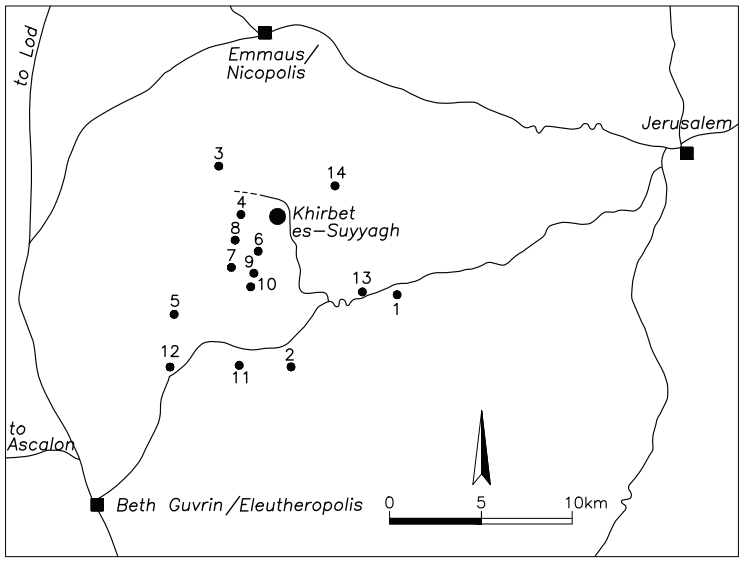

Map of the northern Judaean Hills and Shephelah, showing cities, main roads and main Christian sites in the vicinity of Khirbet es-Suyyagh
Taxel et al (2009) |
Fig. 10.1 - Taxel et al (2009) |
| Description | Image | Source |
|---|---|---|
| Monasteries in the Desert of Jerusalem Early Arab Period |

 Map
MapMap of monasteries in the Desert of Jerusalem (from Y. Hirschfeld, The Judean Desert Monasteries, Map. 1). The underlined sites are the monasteries that survived the Early Arab period. Patrich (2011) |
Map - Patrich (2011) |
| Judean Desert |

 Fig. 1
Fig. 1The route of Euthymius in the Judean Desert. Hirschfeld (1993) |
Fig. 1 - Hirschfeld (1993) |
| Location map of the monastery of Euthymius |

 Fig. 2
Fig. 2Location map of the monastery of Euthymius Hirschfeld (1993) |
Fig. 2 - Hirschfeld (1993) |
| Satellite monasteries around the monastery of Euthymius |

 Fig. 3
Fig. 3Satellite monasteries around the monastery of Euthymius Hirschfeld (1993) |
Fig. 3 - Hirschfeld (1993) |
| Description | Image | Source |
|---|---|---|
| Coastal Palestine 644-800 CE |

 Fig. 1
Fig. 1Location map ■ = urban/semi-urban/military settlement • = rural settlement Taxel (2013) |
Fig. 1 - Taxel (2013) |
| Early Islamic Palestine |

 Figure 1
Figure 1Location map I. Taxel; N. Zak, Israel Antiquities Authority Taxel (2019) |
Fig. 1 - Taxel (2019) |
| Provincial Borders of the ajnad |
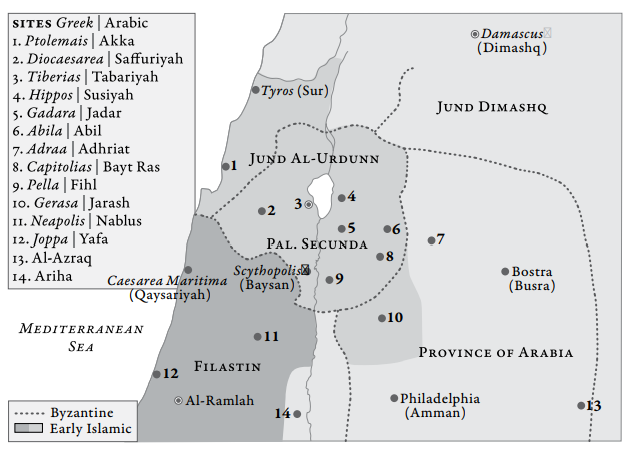
 Figure 3
Figure 3Map showing the rearrangement of provincial borders with the formation of the ajnad Walmsley (2007) |
Fig. 3 - Walmsley (2007) |
| E Mediterranean - early 8th century |

 Figure 1
Figure 1The east Mediterranean in the early eighth century, showing principal sites mentioned in the text Walmsley (2007) |
Fig. 3 - Walmsley (2007) |
| Late Roman and Early Islamic provincs |

 Figure 4.1
Figure 4.1Map of the territories around Baysān/Scythopolis, Fiḥl/Pella and Jarash/Gerasa, showing late Roman and early Islamic provincial structures (Alan Walmsley). Blanke and Walmsley (2022) |
Fig. 4.1 - Blanke and Walmsley (2022) |
| Description | Image | Source |
|---|---|---|
| Sites along the Incense Road |

 Fig. 1
Fig. 1Sites along the Incense Road between Petra and Gaza with an inset of levantine trade routes. (Courtesy of the Israel Antiquities Authority.) Erickson-Gini and Israel (2013) |
Fig. 1 - Erickson-Gini and Israel (2013) |
| The Incense Road |

 Fig. 1a
Fig. 1aThe segment of the Incense road between Petra and Gaza. This segment was compiled using Tsafrir et al.(1994); McCormick (2008) and the locations of Roman milestones (Meshel and Tsafrir 1974, Ben-David 2018 – Person. comm.). Note also the Darb es-Sultan route north of the Incense Road compiled using the maps by Newcombe (1914) and Armstrong (1890)(Figure 2), rectified to the UTM zone 36 N (datum WGS84) Coordinate Reference System (CRS). Zohar and Erickson-Gini (2019) |
Fig. 1a - Zohar and Erickson-Gini (2019) |
| North Incense Road |

 Fig. 4c
Fig. 4cLCP (Least Cost Path) models as potential routes of the Incense Road: Models A1, A2, and B-D representing route analyses between Petra and Oboda. Zohar and Erickson-Gini (2019) |
Fig. 4c - Zohar and Erickson-Gini (2019) |
| Central Incense Road |

 Fig. 4b
Fig. 4bLCP (Least Cost Path) models as potential routes of the Incense Road: Model E representing route analyses between Oboda and Elusa. Zohar and Erickson-Gini (2019) |
Fig. 4b - Zohar and Erickson-Gini (2019) |
| South Incense Road |

 Fig. 4a
Fig. 4aLCP (Least Cost Path) models as potential routes of the Incense Road: Model F representing route analyses between Elusa and Gaza. Zohar and Erickson-Gini (2019) |
Fig. 4a - Zohar and Erickson-Gini (2019) |
| The region between Sha’ar Ramon and Oboda |

 Fig. 5
Fig. 5The region between Sha’ar Ramon and Oboda, where milestones exist. Path Distance LCP model using the slope and distance to water resources as factors are portrayed in blue while the model using only the slope is portrayed in red. Note the similarity of the blue line to the path marked by the milestones except at the Grafon Fort. Zohar and Erickson-Gini (2019) |
Fig. 5 - Zohar and Erickson-Gini (2019) |
| Roman Roads |

 Fig. 2c
Fig. 2cThe network of Roman roads following Tsafrir et al.(1994) and McCormick (2008). Zohar and Erickson-Gini (2019) |
Fig. 2c - Zohar and Erickson-Gini (2019) |
| The Road to Oboda |

 Fig. 2a
Fig. 2aArmstrong’s map portraying the road from the east (noted by arrows) leading to Oboda (Armstrong 1890) Zohar and Erickson-Gini (2019) |
Fig. 2a - Zohar and Erickson-Gini (2019) |
| Map of Roman castella and roads |

 Fig. 2
Fig. 2Map of Roman castella and roads (Alt 1935: 24), showing the location of ‘Barsama’ in the upper left corner Dolinka (2007) |
Fig. 2 - Dolinka (2007) |
| Description | Image | Source |
|---|---|---|
| Jerusalems Historical Basin |

 Main Archeological Sites In Jerusalems Historical Basin
Main Archeological Sites In Jerusalems Historical Basin
Emek Shaveh (2017) |
Emek Shaveh (2017) The Temple Mount/Haram al-Sharif Archaeology in a Political Context |
| Temple Mount |

 Main Ancient Sites On The Temple Mount Al Haram Al Sharif And Its Surrounding
Main Ancient Sites On The Temple Mount Al Haram Al Sharif And Its Surrounding
Emek Shaveh (2017) |
Emek Shaveh (2017) The Temple Mount/Haram al-Sharif Archaeology in a Political Context |
| Silwan |

 Archeological Areas In Silwan
Archeological Areas In Silwan
Emek Shaveh (2017) |
Emek Shaveh (2017) The Temple Mount/Haram al-Sharif Archaeology in a Political Context |
| Temple Mount |


Map of the Temple Mount/Haram al-Sharif with numbered features mentioned in this paper:
(drawing: Gibson) Gibson (2020) |
Fig. 2 - Gibson (2020) |
| Silwan |

 Archeological Areas In Silwan
Archeological Areas In Silwan
Emek Shaveh (2017) |
Emek Shaveh (2017) The Temple Mount/Haram al-Sharif Archaeology in a Political Context |
| Haram - Umayyad Period |


THE HARAM IN JERUSALEM DURING THE UMAYYAD PERIOD Elad (1995) |
Map 1 - Elad (1995) |
| Inset to Map 1 |

 Map 1a
Map 1aInset to Map 1 Elad (1995) |
Map 1a - Elad (1995) |
| Legend to Map 1 and 1a |
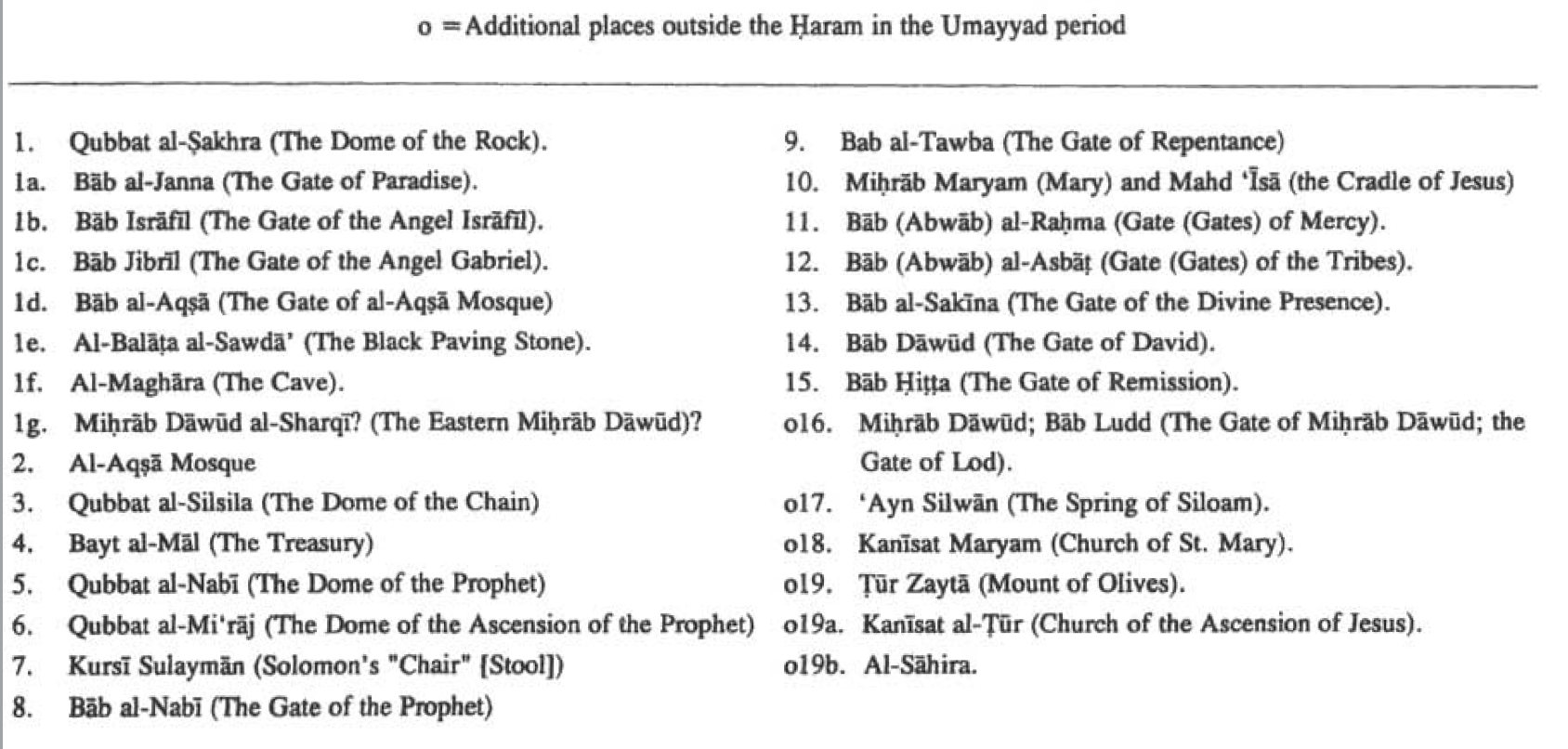
 Legend to Map 1 and Map 1a
Legend to Map 1 and Map 1a
Elad (1995) |
Map 1 and 1a Legend - Elad (1995) |
| Haram - Muslim Pilgrimmage - ~1050 CE |

 Map 2
Map 2THE ITINERARY OF THE MUSLIM PILGRIM TO THE HOLY PLACES OF JERUSALEM ACCORDING TO IBN AL-MURALIA (Beginning and Mid-11th century)
Elad (1995) |
Map 2 - Elad (1995) |
| Inset to Map 2 |

 Map 2a
Map 2aInset to Map 2 Elad (1995) |
Map 2a - Elad (1995) |
| Legend to Map 2 and 2a |

 Map 2 and 2a Legend
Map 2 and 2a Legend
Elad (1995) |
Map 2 Legend - Elad (1995) |
| Jerusalem - 638-1099 CE |

 Map 3
Map 3JERUSALEM DURING THE EARLY MUSLIM PERIOD (638-1099) Elad (1995) |
Map 3 - Elad (1995) |
| Map 3 Legend |

 Map 3 Legend
Map 3 LegendBased on Dan Bahat's map "Jerusalem During the Early Muslim Period-Sites Within the Old City". in The History of Jerusalem.. The Early Islamic Period (638-1099), Jerusalem, Yad Izlhak Ben-Zvi Publications, 1987 Elad (1995) |
Map 3 Legend - Elad (1995) |
Map 1
The main problem when preparing a map of the Haram in the Umayyad period is that the majority of the Arabic sources are from later periods and mostly relate to those periods.
Another significant problem is that the names of constructions and their locations have changed in the course of time. The double danger arises, therefore, of mistakenly attributing
anachronistic names and dates to buildings found in the Haram to-day but were built at the latest in the later Middle Ages.
On luckier occasions, an early tradition may have been traced relating some details on one monument or another in Jerusalem, of the Umayyad period, but even then it is usually impossible to determine the exact location.
Using the guide lines drawn up here, I was able to assert that the Gate of Repentance (Bab al-Tawba), during the Umayyad period, was in close proximity to Mihrab Maryam.
However, the location of the latter place in the south-east corner of the Haram can only be attributed (with reservation) to the end of the 9th century and clearly so to the 10th and 11th centuries.
Although the eastern Mihrab Dawud is mentioned by the early (7th-8th century) sources, I was unable to locate it.
The same considerations were important in locating the Dome of the Chain (Bab al-Silsila), the Gate of The Divine Presence (Bab al-Sakina), the Dome of Ascension (Qubbat al-Mi `raj)
and other monuments on the Haram from the Umayyad period.
I only used the procedure just described when places or monuments were mentioned in a source that I estimated to date back to the Umayyad period.
Not included in this map are monuments mentioned by late sources which allude to their existence during the Umayyad period, such as the mention by
al-Muhallabi (mid-10th century) of the Dome of the Scale (Qubbat al-Mizan) and the Dome of the Gathering (Qubbat al-Mahshar).
Still, al-Muhallabi does refer to the Dome of Ascension (Qubbat al-Mi `riij) and the Dome of the Prophet (Qubbat al-Nabi),
which were both mentioned by much earlier sources in their account of the Umayyad period. Al-Muhallabi's description of the
latter monuments may, therefore, serve as additional proof to earlier sources, that these indeed existed in the Umayyad period.
Greenberg, R. (2019). The Archaeology of the Bronze Age Levant: From Urban Origins to the Demise of City-States, 3700-1000 BCE. India: Cambridge University Press.
Tsafrir, Yoram (2016) An annotated map of Byzantine settlements in Israel
in Ahrweiler, H. (2016). Géographie historique du monde méditerranéen. France: Éditions de la Sorbonne
Tsafrir, Yoram (1982) Annotated Map of Archaeological Discoveries of Byzantine Antiquities in Israel
in Ahrweiler, H. (1988). Géographie historique du monde méditerranéen. France: Éditions de la Sorbonne - open access at archive.org
Exploration
- Horvat Tov in Google Earth
- Horvat Tov on govmap.gov.il
- Unexcavated Fortress (?) just N of Horvat Tov on govmap.gov.il
Terms and Definitions
terminus post quem - the earliest possible date for something.
terminus ante quem - the latest possible date for something..
terminus a quo - the earliest possible date for something.
terminus ad quem - the point at which something ends or finishes.
Numismatics
Archaeomagnetism
- excerpts from ars technica
So, once the iron is heated past 770°C, it loses it's magnetism. Once it cools back down below 770°, it then regains it's magnetism and what will happen is that the magnetic domains in the iron will tend to line up in the direction of any external magnetic field - which would be the Earth's field.
Now, while they do not know which way the pots were facing in the kiln, nor do they know what direction the kiln was facing, the orientation and arrangement of the magnetic domains can show the strength of the magnetic field and, knowing that the handles in the pots were generally horizontal, they can also show the azimuth of the field - the direction it's pointing up or down.
... During the 1st millennium BCE, the kingdom of Judah was a bustling urban civilization, full of markets, bureaucrats, and scholars. They used an ancient lunar calendar system, and chroniclers noted the years of each new political regime as well as other significant social changes. At Tel Socoh, in Judah, there was a small industry devoted to the production of storage jars, and the artisans there carefully stamped the ruling monarch's symbols into each jar's handle. When archaeologists compare historical records with these symbols, it's relatively straightforward to get an exact date for a jar's manufacture. Luckily for geoscientists in the 21st century, jar handles tend to survive longer than other bits of pottery.
The practice of stamping storage jars with royal seals as part of a taxation administrative system was widespread in Judah between the 8th and the 2nd centuries BCE (Lipschits, 2021). During the manufacturing of large oval four‐handled storage jars, some specific jars were pre-labeled by stamping an impression onto the wet clay just before firing. These stamped jars were used for delivering goods, such as wine or oil as tax. Over time, due to political and economic changes, the seal impression systems evolved; some systems went out of use and other systems replaced them. As a result, the different families of seals, each distinguished by a unique symbolic motif, formed a continuous typological framework that can be linked to an absolute historical chronology.
The Judahite stamped jar system has been thoroughly studied (Bocher & Lipschits, 2013; Koch & Lip schits, 2013; Lipschits, 2021; Lipschits & Vanderhooft, 2011, 2014; Lipschits et al., 2010; Ornan & Lip schits, 2020; Vanderhooft & Lipschits, 2007) and was recently summarized by Lipschits (2021), who provided a comprehensive classification of the seals according to their iconographic motifs and time of use. Figure 1 displays the seven main impression categories discussed in this study and their age spans. Each impression category has a series of variants, hereafter referred to as “types,” and even “sub-types.” Archaeologically, it is difficult to distinguish between the time of use of the various types within a specific impression category. Hence, we group the archaeomagnetic samples according to type and assign them similar age spans in an effort to investigate possible temporal relationships. The collection we use was excavated from several sites, mostly from Ramat Rahel and Tel Azekah, but also from Socoh and several excavations in Jerusalem (Figure 2, Table S1). Only the type is used as a consideration for arranging samples into groups, while the location in which the jar was found is a parameter that is not taken into account when defining groups. Our work continues the study of Ben-Yosef et al. (2017), who carried out an archaeointensity analysis of stamped jars and reported data from 27 samples: 23 of which belong to the main impression categories shown in Figure 1,three of which are private stamps that are not shown in the figure and one is an incision impression (concentric circle). These data are included in our revised analysis as detailed below.
The lmlk impression system was the first to be used. It consists of three main components: the Hebrew word lmlk, meaning “(belonging) to the king” in the upper part of the stamp impression, a royal emblem in the center, and a name of a place in the lower part. The combinations of two different royal emblems, four names of places and several patterns for the positioning of the letters around the symbol define nineteen different seal types. The lmlk impression system is divided into two categories: lmlk early and lmlk late. The former was in use before the destruction of Judah by Sennacherib in 701 BCE, and the latter was in use under the first era of the Assyrian administration in the 7th century BCE. The three “lmlk late” types studied here- MIIb, ZIIb and XII (Figure S1 in Supporting Information S1) are dated to 701–630 BCE, following the maximum age range of the lmlk im pressions suggested by Ben-Yosef et al. (2017).
The Rosette impressions are small and rounded and bear a single rosette motif with no inscription. The stamp types differ in the number and shape of the petals, the existence or non-existence of a frame, and an inner core. The Rosette stamp impressions went out of use during the final destruction of Judah by the Babylonians in 586 BCE.The date of their introduction is less clear, so we set the earliest possible date to 660 BCE, following Vaknin et al. (2020).
The Lion impressions are small and mostly rounded in shape. They include the image of a lion depicted in profile in various positions, with no inscription. Six types are studied here: lion type 3,4,5,6,7, and 8 (Figure S2 in Supporting Information S1). The Lion impression system was in use under Babylonian rule, that is, after the 586 BCEdestruction of Judah. When the Persians took over Judah in ca. 539 BCE, this system was gradually replaced by the yhwd stamp impression system. Thus, the use of Lion impressions is estimated between 586 BCE and ca. 520 BCE.
The yhwd impressions represent a transition from the use of symbols to script only. This complex system consists of 17 types with more than 50 variations. It was used for about 400 years from the late 6th century BCE until the second half of the 2nd century BCE. The yhwd impressions are chronologically divided into three categories: early, middle, and late (Figure S3 in Supporting Information S1) on the basis of the following criteria: their paleographic properties, a linguistic study of the transition from Aramaic to the Hebrew language, comparison of the impressions with the yhwd coins minted in the same periods of time, and on the basis of the historical context of the development of Judah under the rule of the Persian, Ptolemaic and the Seleucid empires (Lipschits & Vanderhooft, 2011).
The yrslm impressions represent a new era with the reappearance of iconographic elements alongside writing. The impressions include a pentagram with a script in ancient Hebrew reading yrslm (“Jerusalem”) between its vertices. Here, we focus on five types: a, b, c, d, and f (Figure S4 in Supporting Information S1), where we unite type c and type d into a single type labeled c/d because of the difficulty in distinguishing between them. The yrslm impression is associated with the weakening of the imperial hold on the region, the Maccabean revolt (ca. 167 160 BCE), and regaining full independence under Simon Maccabaeus (142 BCE). Therefore, we estimate the age span of yrslm impressions to ca. 200–140 BCE (Bocher & Lipschits, 2013)
- from Hassul et al. (2024)
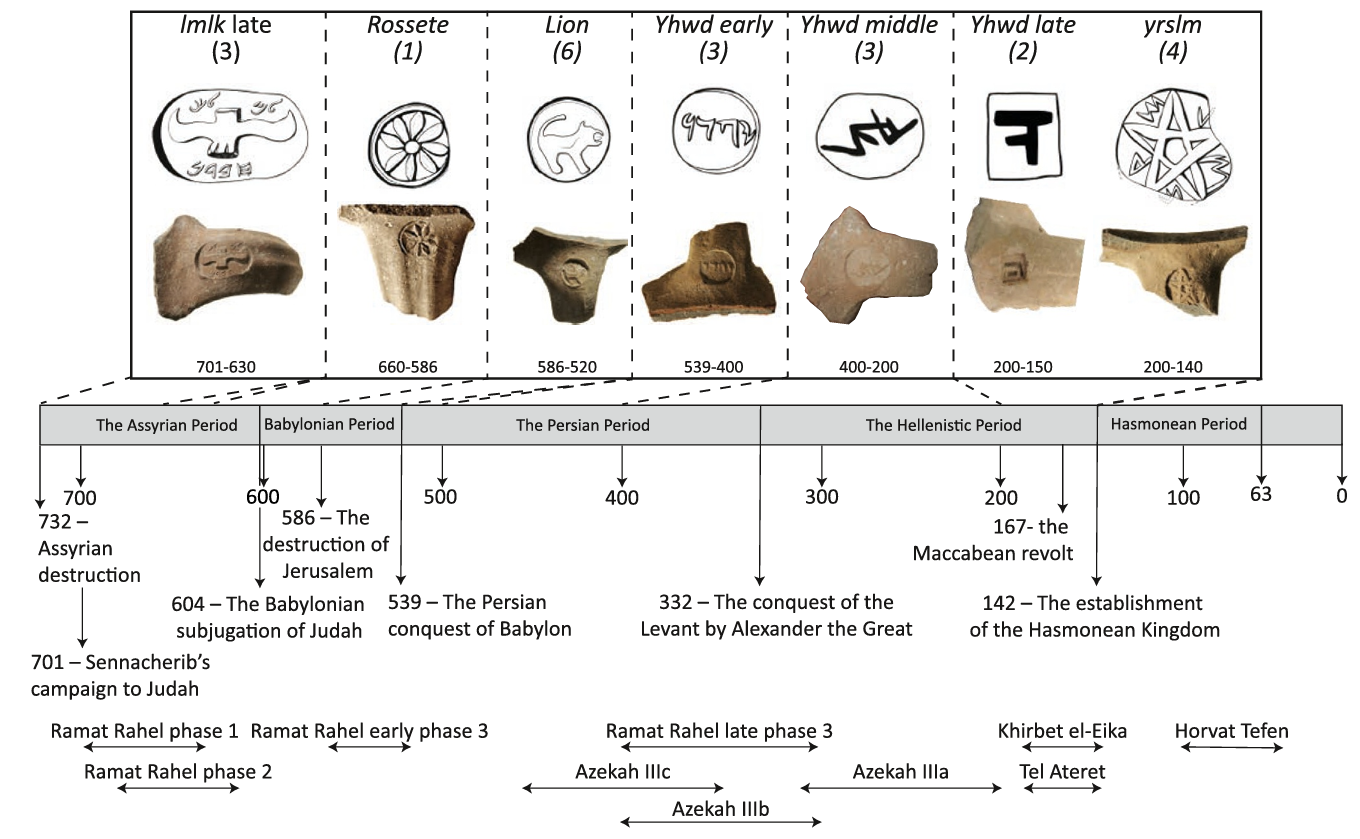 Figure 1
Figure 1Judean stamp impressions and chronological framework. Each panel in the top row shows a schematic illustration, a representative picture of a stamp category, and its estimated age of use. The number of types (archaeomagnetic groups) analyzed in this study is indicated in brackets under the impression name. The time scale indicates the main historically dated events mentioned in the text. The lower row shows the age of the other archaeological contexts; all ages provided are BCE.
Redrawn following Lipschits (2021).
Hassul et al. (2024)
- from Hassul et al. (2024)
 Figure 8
Figure 8LAC.v.2.0 and comparison with predictions of geomagnetic models. The black curve and gray area show the mean values and the 95% credible interval. Models were calculated for the location of Jerusalem (31.78°N, 35.20°E).
Hassul et al. (2024)
- from Hassul et al. (2024)
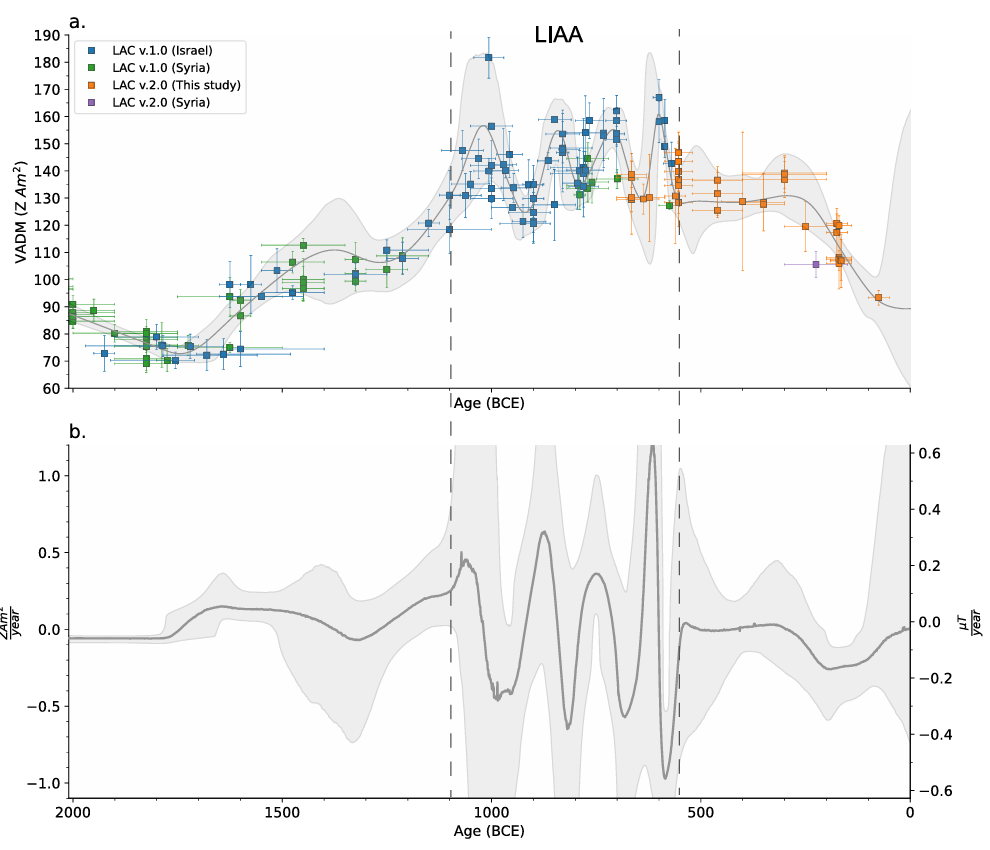 Figure 9
Figure 9Duration of the Levantine Iron Age Anomaly.
- LAC.v.2.0: data and curve during the first two millennia BCE
- Rate of change in field intensity and VADM [virtual axial dipole moment]
Hassul et al. (2024)
